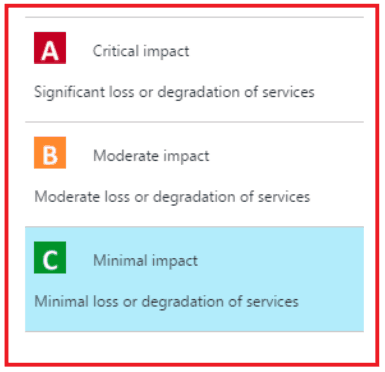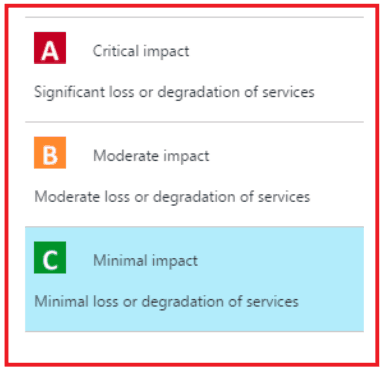It Pays to Know Your A, B, C Severity Levels of Microsoft Unified Support.

It Pays to Know Your A, B, C Severity Levels of Microsoft Unified Support

You can check out our page breaking down the Unified Support differences, but one area we could not foresee was how the transition would impact Microsoft’s ability to respond to an increase in support requests.
If your enterprise has been integrated into Microsoft’s new Unified Support program, which transitioned away from Premier starting in July 2018, you’re well aware that there are three tiers to Microsoft Unified Support: There are unlimited reactive support hours and there are three levels – Core, Advanced, Performance – which have a minimum contract size of $25,000, $50,000, and $175,000, and pricing based on a percentage of Office 365 annual costs, client software annual costs, other software and online annual costs.
It was clear that Unified Support Core and Advanced tiers would offer 2x to 4x slower responses versus Microsoft Premier Support: Previous wait times were 1 hour for “catastrophic” issues and 2 hours for standard tickets. New Unified Support contracts now commit to 1 hour for “critical” / 8 hours standard for Core and 1 hour “critical” / 4 hours standard for Advanced. Those at the highest tier, Performance, saw initial response time service level agreements (SLAs) drop from one hour to 30 minutes for “critical” cases only, while the standard ticket wait times doubled to 4 hours.
With an unlimited amount of support tickets you could submit without worrying about your support, many companies took a wait-and-see approach to gauge how Microsoft would keep up to demand.
Severity Levels and Your Situation
In our conversations with companies who have purchased Microsoft Unified Support, many Small and Medium Enterprises (SME) that purchased Unified Core or Advanced Support are seeing slower response times than promised. When you have a support issue, you submit your ticket into Microsoft’s Unified Portal. When you do this, you must identify the level of severity for your issue: A, B or C. Here’s a table outlining Microsoft’s definition of each level of severity:
| Severity Level | Your Situation |
| Severity A | Critical Business Impact – your business has experienced a significant loss or degradation of services, requiring immediate attention. |
| Severity B | Moderate Business Impact – you have a loss or degradation of services, but your organization can still function. |
| Severity C | Minimum Business Impact – you have an issue, but it has a small impact on your business. |
Customers Are Struggling
Many Microsoft Unified Support customers we speak with are struggling to get responses from Microsoft when they are putting in support tickets as Severity B or Severity C.
If you haven’t ensured you have aggressive SLAs that are financially backed in your support contract, you may be forced to wait if you aren’t paying top dollar for the highest level of Unified Support. Since the Advanced tier of Unified Support doesn’t make business sense for most SMEs, they are trying to work around the issue by submitting all tickets as Severity A.
As Microsoft continues its push to onboard customers onto Office 365 and Azure, the companies we’re speaking with are worried this will only continue to get worse, with demand outpacing available support. At US Cloud, we’re also seeing that Office 365 and Azure are the top support topics for our Microsoft enterprise support services customers – we are able to work with enterprises of all sizes to ensure they are maximizing the potential of their investments in Microsoft software and services.
Optimize MSFT Support Costs Now to Emerge Stronger Than Competitors
Gartner has identified US Cloud as the only independent third-party support alternative to Microsoft. Enterprises can replace MSFT Premier/Unified with US Cloud and drop an immediate costs savings of 30-50% in year 1.
